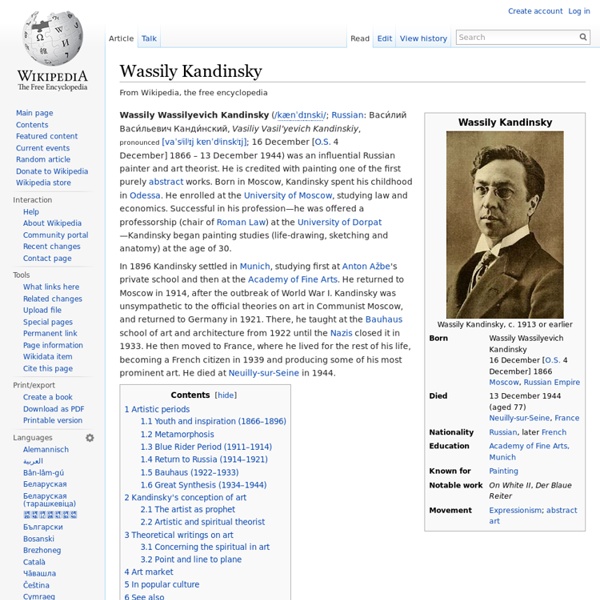Jean Arp
Jean Arp / Hans Arp (16 September 1886 – 7 June 1966) was a German-French, or Alsatian, sculptor, painter, poet and abstract artist in other media such as torn and pasted paper. When Arp spoke in German he referred to himself as "Hans", and when he spoke in French he referred to himself as "Jean". Many people believe that he was born Hans and later changed his name to Jean, but this is not the case. Early life[edit] Arp was born in Strasbourg as the son of a French mother and a German father, during the period following the Franco-Prussian War when the area was known as Alsace-Lorraine (Elsass-Lothringen in German) after France had ceded it to Germany in 1871. Following the return of Alsace to France at the end of World War I, French law determined that his name become Jean. In 1904, after leaving the École des Arts et Métiers in Strasbourg, he went to Paris where he published his poetry for the first time. Career[edit] Arp was a founding member of the Dada movement in Zürich in 1916.
Sculptures Popping Out of Paintings
Oh, to have been in Tokyo in June! Shintaro Ohata just finished up a solo exhibition at the Yukari Art Contemprary in Tokyo, Japan. This Hiroshima, Japan-born artist is known for his ability to show us everyday life in a cinematic way. More than that, this artist has a unique style. Straight from the Yukari gallery, here's a sample of his stellar work. ' Photos courtesy of Yukari Art Contemporary.
Mark Rothko
Mark Rothko (Latvian: Markus Rotkovičs, Russian: Марк Ро́тко; born Ма́ркус Я́ковлевич Ротко́вич; Marcus Yakovlevich Rothkowitz; September 25, 1903 – February 25, 1970) was an American painter of Russian Jewish descent. He is generally identified as an Abstract Expressionist, although he himself rejected this label and even resisted classification as an "abstract painter." With Jackson Pollock and Willem de Kooning, he is one of the most famous postwar American artists. Childhood[edit] Mark Rothko was born in Dvinsk, Vitebsk Governorate, in the Russian Empire (today Daugavpils in Latvia). Despite Jacob Rothkowitz's modest income, the family was highly educated ("We were a reading family," Rothko's sister recalled[2]), and Rothko was able to speak Russian, Yiddish, and Hebrew. Emigration from Russia to the U.S. Fearing that his sons were about to be drafted into the Imperial Russian Army, Jacob Rothkowitz emigrated from Russia to the United States. Rothko received a scholarship to Yale.
The National Gallery, London: Western European painting 1250–1900
Joan Miró
Earning international acclaim, his work has been interpreted as Surrealism, a sandbox for the subconscious mind, a re-creation of the childlike, and a manifestation of Catalan pride. In numerous interviews dating from the 1930s onwards, Miró expressed contempt for conventional painting methods as a way of supporting bourgeois society, and famously declared an "assassination of painting" in favour of upsetting the visual elements of established painting.[1] Biography[edit] Born into the families of a goldsmith and a watch-maker, he grew up in the Barri Gòtic neighborhood of Barcelona.[2] His father was Miquel Miró Adzerias and his mother was Dolors Ferrà.[3] He began drawing classes at the age of seven at a private school at Carrer del Regomir 13, a medieval mansion. Career[edit] Illustration for Cavall Fort, a children's magazine in Catalan Miró initially went to business school as well as art school. In 1924, Miró joined the Surrealist group. Late life and death[edit] Works[edit]
fantastic archtecture
Salvador Dalí
Salvador Domingo Felipe Jacinto Dalí i Domènech, 1st Marqués de Dalí de Pubol (May 11, 1904 – January 23, 1989), known as Salvador Dalí (/ˈdɑːli/;[1] Catalan: [səɫβəˈðo ðəˈɫi]), was a prominent Spanish surrealist painter and sculptor born in Figueres, Catalonia, Spain. Dalí was a skilled draftsman, best known for the striking and bizarre images in his surrealist work. His painterly skills are often attributed to the influence of Renaissance masters.[2][3] His best-known work, The Persistence of Memory, was completed in August 1931. Dalí's expansive artistic repertoire included film, sculpture, and photography, in collaboration with a range of artists in a variety of media. Dalí attributed his "love of everything that is gilded and excessive, my passion for luxury and my love of oriental clothes"[4] to an "Arab lineage", claiming that his ancestors were descended from the Moors. Dalí was highly imaginative, and also enjoyed indulging in unusual and grandiose behavior. Biography[edit]
drawn. - theprintspace illustration show
Kurt Schwitters
Kurt Hermann Eduard Karl Julius Schwitters (20 June 1887 – 8 January 1948) was a German painter who was born in Hanover, Germany. Early influences and the beginnings of Merz, 1887-1922[edit] Das Undbild, 1919, Staatsgalerie Stuttgart Hanover[edit] Kurt Schwitters was born on 20 June 1887, at No.2 Rumannstraße,[1][2] Hanover, the only child of Edward Schwitters and his wife Henriette (née Beckemeyer). After studying art at the Dresden Academy alongside Otto Dix and George Grosz, (although Schwitters seems to have been unaware of their work, or indeed of contemporary Dresden artists Die Brücke[3]), 1909–15, Schwitters returned to Hanover and started his artistic career as a post-impressionist. Schwitters spent the last one and half years of the war working as a technical draftsman in a factory just outside Hanover. "In the war [at the machine factory at Wülfen] I discovered my love for the wheel and recognized that machines are abstractions of the human spirit Der Sturm[edit] The Merzbau[edit]



